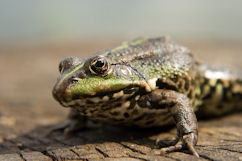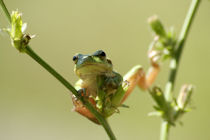The need for amphibian conservation is clear. However, the lack of a clear understanding of the factors causing amphibian declines makes the achievement of positive results in this area quite challenging.

I agree with opinions of those authors who state that amphibian conservation will probably be most efficient if implemented as part of broader animal conservation strategies and within the framework of protecting not only particular amphibian species and other endangered animals but the whole ecosystems.
A recent joint effort by leading environmental organizations IUCN – World Conservation Union, Conservation International and NatureServe resulted in the release of a comprehensive assessment of the world’ amphibian species in 2004 (Global Amphibian Assessment). The study is now being used to develop and implement conservation strategies to help protect threatened amphibians. (1)

The study found that Latin American countries have the largest number of threatened amphibian species with Colombia, Mexico and Ecuador topping the list. (2)
But the highest levels of threat for amphibians are in the Caribbean Basin with some countries reaching the levels of 80-90% (!) of all of their amphibian populations under threat. (3)
Scientists working for the Global Amphibian Assessment program came up with a number of conservation strategies and policy measures in an attempt to prevent further global amphibian declines.

In order for the global community to be successful in stemming further declines of amphibian species, the scientists stressed the need for further research into the causes of amphibian declines and extinctions (such as: emerging amphibian diseases, for example, the ones caused by fungi; climate change; environmental contamination) as well as the need for the continuing documentation of amphibian diversity and how it is changing. (4)
Here are some of their main recommendations for amphibian conservation: (5)
- Protection of Key Sites for Amphibian Survival
This is a very important objective as the habitat loss and degradation are affecting nearly 90% of all threatened amphibians.
- Reintroduction
The aim of this measure is to re-establish viable amphibian populations in the wild where conventional habitat management techniques are not effective to secure amphibian population recovery.
If required, captive breeding may be used to provide amphibians for reintroduction into the wild.
- Control of Harvesting
Amphibians have been traditionally a source of food and medicines in a number of countries, specifically in some Asian societies. And this (in addition to the international pet trade), has resulted in significant amphibian declines.
Therefore management of such commercial harvesting has been proposed as another measure for protecting amphibians.
The scientists have also called for the establishment of an “amphibian emergency fund” that would be in place to address immediate threats to the survival of amphibian populations. (6)
Some other sources suggest more specific measures such as providing corridors to facilitate the migration of the populations of amphibians between each other or conducting periodic translocations among separated populations in fragmented habitats. This can help facilitate the gene flow between populations. (7)
Causes of Amphibian Declines
In the last 10 – 15 years we have witnessed a surge of interest in the welfare of amphibian species in general and amphibian conservation in particular.
This has been due to the fact that, by the end of the 1990s, researchers were observing the rapid and difficult to explain declines in amphibian populations around the world, specifically in rainforests.
Such declines presented a mystery to many people as they were taking place in undisturbed ecosystems with no apparent human-caused factors such as deforestation. (2)
A number of authorities in this field point out several major causes of amphibian decline.
The most common factors put forward as possible explanations are:
- Climate Change
This factor has been widely referred to as a likely reason for “simultaneous changes in distant populations”. (3)
B. Waldman and M. Tocher give an excellent explanation of this:
“Even short-term variation in weather patterns can dramatically affect amphibian populations. Amphibians need moist habitats to live and reproduce, so desiccation is an incessant threat. The abundance and composition of the invertebrate prey in their diet is likely to shift with changing environmental conditions. Reproductive behaviors, spatial distributions, and vulnerability to predation and disease are likely to change as conditions become warmer or drier…
Altered weather patterns may be responsible for wide-ranging declines of frog populations in Brazil … and the possible extinction of the golden toad Bufo periglenes in Costa Rica…” (4)
However, the authors go on to mention that changing weather conditions cannot explain many of amphibian declines. (5)
- Acid Rain
B. Waldman and M. Tocher point out that acid rain was suggested a long time ago as a likely threat for amphibians because of its effects on the larval survivorship and general development. (6)
Yet again, acid rain cannot explain problems with all declining amphibian populations globally.
- Pesticides, Herbicides, and Fertilizers
These chemicals “can retard growth and disrupt the capability of amphibians to survive and reproduce”, especially that they “can spread vast distances through the upper atmosphere in mist or fog to contaminate remote, otherwise pristine, regions”. (7)
- Habitat Loss / Damage
This factor has been mentioned in a vast number of academic publications and mass media.
We have mentioned in the Tropical Frogs’ article how dependent the frogs are on their specific habitats.
Among other things, the habitat damage can happen through rainforest destruction / deforestation (resulting in habitat loss) or habitat degradation (such as fragmentation of a forest into isolated areas, for example (8)).
B. Waldman and M. Tocher note that local populations of frogs are normally connected through the individuals visiting each other. And this is important for maintaining their genetic diversity. But in a fragmented forest habitat, such interactions between the populations can become very difficult which in turn can lead to the species’ declines and extinction. (9)
- Pathogens Attacking the Frogs
Researchers discovered that pathogens, such as fungi, can be a serious cause for epidemic die-offs of frog populations. (10)
Chytrid fungus, for example, was known to attack plants and insects before, but never vertebrates. This fungus has now been found to attack frogs and has become a major cause of amphibian declines. (11)
One thesis suggests that a number of negative environmental changes have weakened the frogs’ immune system to the level that they have become susceptible to the threats that they were managing to ward off before. (12)
Many experts rush to point out that it is most likely a combination of many factors that cause the wide-ranging damage to the frogs on a global scale.
B. Waldman and M. Tocher conclude that
We will not be too wrong to suggest that the factors that we’ve mentioned above are at least some of the reasons why many amphibian species (for example, the golden poison dart frog) have now become endangered animals.
